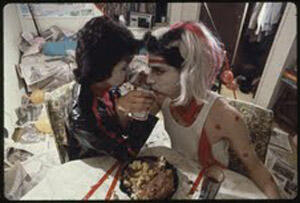_Asco: Elite of the Obscure, a Retrospective (1972-1987)_ arrives at the MUAC, Mexico City
The Museo Universitario de Arte Contemporáneo (MUAC), from the Universidad Nacional Autónoma de México (UNAM), will inaugurate on March 21st, the first retrospective of the conceptual and performance art collective ASCO.

This exhibition is organized by the Los Angeles County Museum of Art (LACMA) and the Williams College Museum of Art, with support of the Andy Warhol Foundation for the Visual Arts, the National Endowment for the Arts and the Robert Mapplethorpe Foundation.
Asco: Elite of the obscure, a retrospective 1972-1987 is the first exhibition to present the broad scope of work of the Chicano group Asco, that operated in Los Angeles between 1972 and 1987. The group of artists comprised Harry Gamboa Jr., Gronk, Willie F. Herron III and Patssi Valdez. Taking their name from the arresting Spanish word for repugnance and nausea, Asco used performance, public and multimedia art to respond to socially and politically turbulent times in Los Angeles and worldwide. The art collective was active until the mid 1980s, and grew to include the artists Diane Gamboa, Sean Carrillo, Daniel J. Martínez and Sandoval Teddy, among others.
Geographically and culturally segregated from the then emergent contemporary art scene in Los Angeles, and aesthetically distinct from Chicano art movement, Gamboa, Gronk, Herron and Valdez came together to explore and exploit the media without conceptual limits. Creating art using any and all methods available to them, Asco fused activism with performance in a process that expanded the scope of Chicano art.
The exhibition, curated by Rita González and C. Ondine Chavoya, shows the various aesthetic and critical tactics employed by the group. It includes video projections, sculpture, painting, performance and documentation, collage, postal art, photography and, in particular, their No-Movies: performances that invoke the formal codes of cinema with the aim of repeating their distribution and advertising strategies, but which are created for a still camera. The ultimate aim of the collective was to avail of its self-imposed exile in order to subvert the historical process that led to the idea of the Chicano as a blind spot for media and political and cultural institutions, and to create platforms of critical visibility for the Chicano community.





